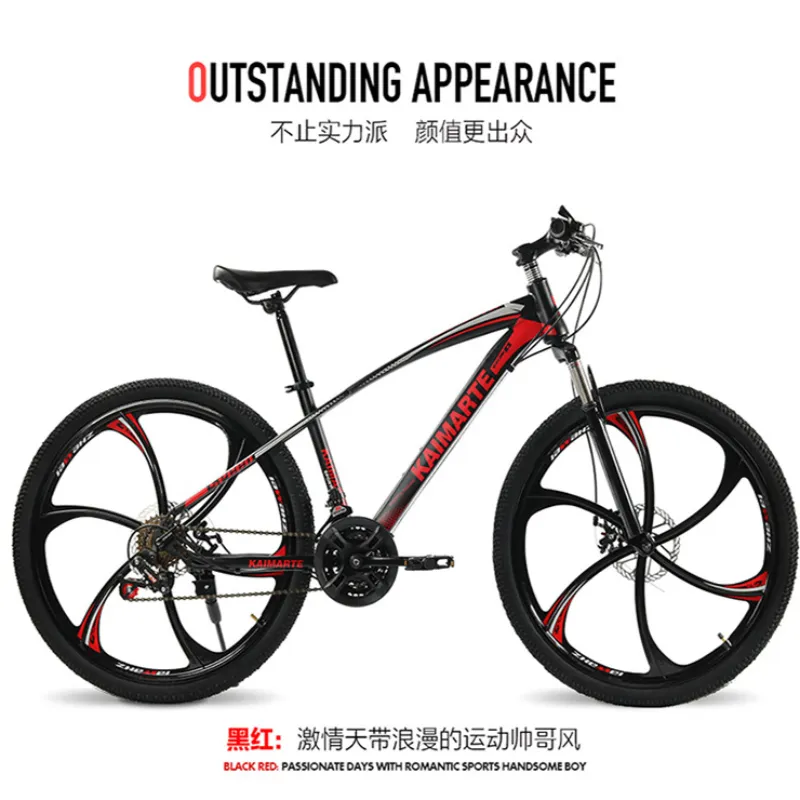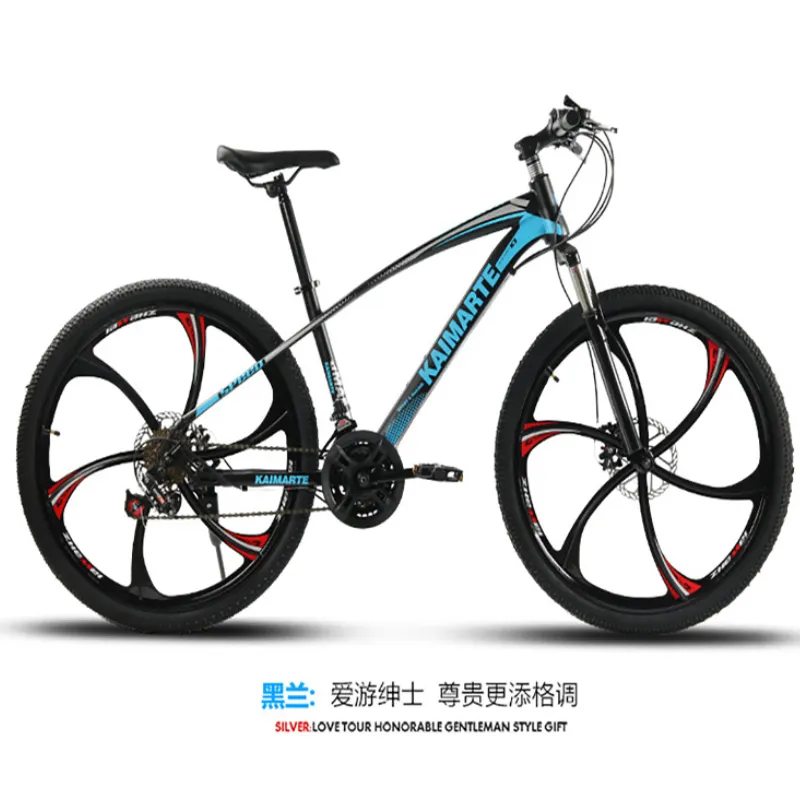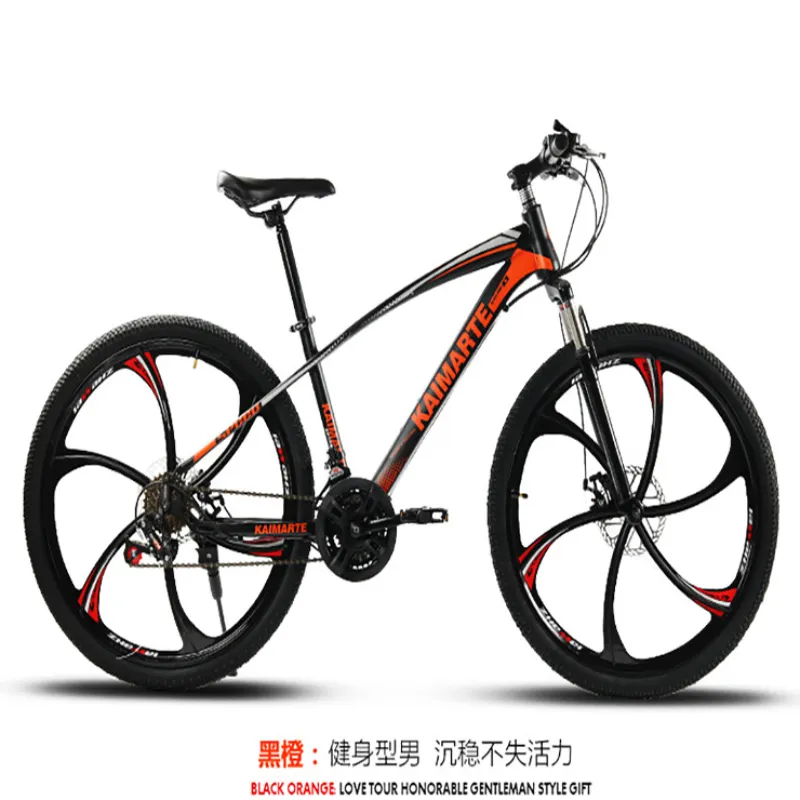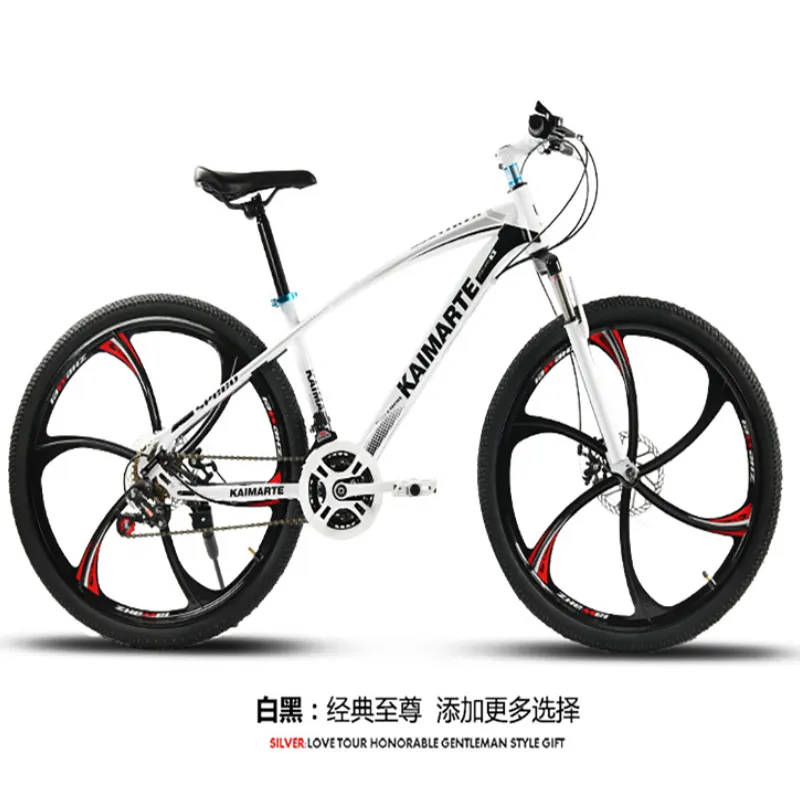Aug . 18, 2025 02:00 Back to list
26 Inch Mountain Bikes: Durable & Agile Trail Performance
The Resurgence and Relevance of the 26 inch mountain bike in Modern Cycling
In the dynamic landscape of outdoor recreation and utility cycling, the 26 inch mountain bike continues to carve out a significant niche, proving its enduring versatility and performance capabilities. While newer wheel sizes have emerged, the 26-inch platform, epitomized by products like the Mountain Bike 26 Inch Shock-Absorbing Outdoor Riding Variable Speed Dirt Bike, maintains its relevance for specific applications requiring unparalleled agility, robust construction, and ease of maintenance. This section delves into the evolving industry trends that underscore the continued demand for the 26-inch format, highlighting its advantages in diverse operational contexts, from challenging off-road trails to urban tactical use. The compact wheel size translates directly into a more nimble handling experience, making it a preferred choice for intricate singletracks, technical descents, and environments where rapid directional changes are paramount. Furthermore, its inherent strength and durability, often a result of a tighter wheel spoke geometry and robust frame design, contribute to a longer service life, reducing the total cost of ownership for B2B entities considering fleet integration. The market has witnessed a renewed appreciation for the 26-inch wheel, particularly in sectors where reliability, repairability, and specific performance characteristics outweigh the pursuit of maximum roll-over capability. This includes specialized segments such as dirt jumping, park riding, and, increasingly, compact urban delivery or security patrol applications where maneuverability in confined spaces is critical.
The technological advancements in frame materials, suspension systems, and drivetrain components have revitalized the performance envelope of the 26 mountain bike. Modern iterations are far from their predecessors, incorporating lightweight alloys, advanced carbon fiber composites, and finely tuned hydraulic disc brake systems. These enhancements address historical limitations, elevating the ride quality and safety standards. For organizations, this means access to a highly adaptable asset that can perform reliably across various terrains and operational demands. Whether deployed for recreational rental fleets in mountainous regions, as essential transport for remote site inspections, or integrated into law enforcement and emergency response units, the 26-inch platform offers a compelling balance of cost-effectiveness and performance. Its proven track record in extreme sports disciplines also testifies to its inherent strength and capacity to withstand rigorous use, a critical factor for B2B applications where equipment longevity and minimal downtime are direct contributors to operational efficiency. Understanding these intrinsic qualities and market dynamics is crucial for decision-makers evaluating cycling solutions for their specific business needs, demonstrating why the 26inch mountain bike remains a viable and often superior choice for targeted applications.
Advanced Manufacturing & Quality Assurance for Your 26in Mountain Bike
The robust performance and reliability of a modern 26 inch mountain bike are fundamentally rooted in a meticulous manufacturing process that adheres to stringent international quality standards. The journey begins with the selection of premium materials, typically high-grade aluminum alloys (e.g., 6061 or 7005 series) for frames, renowned for their strength-to-weight ratio and corrosion resistance. Steel alloys like Cr-Mo (Chromoly) are also used for specific components, particularly where enhanced vibration damping and fatigue resistance are critical. The frame fabrication typically involves hydroforming or mechanical forming of tubes, followed by precision TIG (Tungsten Inert Gas) welding, a process chosen for its strong, clean welds and minimal heat distortion. Advanced manufacturing techniques like CNC (Computer Numerical Control) machining are employed for critical components such as dropouts, disc brake mounts, and suspension linkages, ensuring exact tolerances and optimal integration. For higher-end models, carbon fiber composite manufacturing involves intricate lay-up schedules and resin infusion processes, delivering exceptionally lightweight yet stiff structures.
Quality control is integrated at every stage, from raw material inspection to final assembly. Key manufacturing processes undergo rigorous checks. For instance, after welding, frames are heat-treated to restore material strength and then subjected to alignment checks using precision jigs to ensure perfect geometry, crucial for handling and stability. Surface preparation, including sandblasting or chemical cleaning, precedes multi-layer painting or powder coating, which provides not only aesthetic appeal but also a durable, corrosion-resistant finish, vital for a bike exposed to harsh outdoor elements. Performance testing aligns with international standards such as ISO 4210 (Safety requirements for bicycles) and EN 14766 (Mountain bicycles – Safety requirements and test methods), covering fatigue testing of frames, forks, and handlebars, brake performance, and impact resistance. These tests simulate real-world stresses, guaranteeing that each 26 mountain bike component can withstand the rigors of aggressive riding. The projected service life of a well-maintained 26-inch mountain bike, built to these standards, can extend over a decade, making it a sustainable investment for B2B operations. This meticulous approach ensures high reliability and reduced maintenance needs, directly contributing to operational efficiency and safety across various application scenarios, where durability and consistent performance are paramount.

The application of these high manufacturing standards translates into significant advantages for the end-user. For instance, the use of triple-butted aluminum tubing, common in quality 26 in mountain bike frames, strategically removes material from low-stress areas while retaining thickness where strength is needed most, leading to a lighter yet stronger frame. This optimization contributes to improved energy transfer from the rider to the wheels, enhancing overall efficiency and reducing rider fatigue over extended periods. Furthermore, advanced electrophoretic deposition (EPD) or powder coating techniques applied to the frame and components provide superior resistance to chipping, scratching, and environmental corrosion, extending the bike's aesthetic appeal and structural integrity even when exposed to demanding outdoor conditions. This focus on long-term durability and resistance to wear and tear makes the 26inch mountain bike a highly attractive option for sectors requiring robust and low-maintenance equipment. The comprehensive testing protocols, including specific tests for shock absorption systems and variable speed drivetrains, ensure that the product not only meets but often exceeds industry benchmarks, providing confidence in its performance and safety for any demanding B2B application.
Key Technical Parameters & Performance Analysis of the 26inch Mountain Bike
Understanding the technical specifications of a 26inch mountain bike is crucial for appreciating its performance characteristics and suitability for specific applications. Modern 26-inch models, such as the Mountain Bike 26 Inch Shock-Absorbing Outdoor Riding Variable Speed Dirt Bike, are engineered with a sophisticated blend of components to deliver an optimal riding experience. The frame geometry is typically optimized for agility, featuring steeper head tube angles and shorter chainstays compared to larger wheel sizes, which contributes to quicker steering and easier maneuverability in tight spaces. Suspension systems, either front (hardtail) or full-suspension, are critical for absorbing impacts. Front forks commonly offer 80-120mm of travel, utilizing coil or air springs, with hydraulic damping for controlled rebound. Full-suspension systems integrate rear shocks, often with similar travel ranges, designed to enhance traction and rider comfort over rough terrain.
The drivetrain usually comprises a variable speed system, ranging from 7-speed to 27-speed or more, leveraging robust components from reputable manufacturers like Shimano or SRAM. This wide gear range ensures versatility across various gradients, from steep climbs to fast descents. Braking performance is paramount for safety and control; hydraulic disc brakes are standard, offering superior stopping power and modulation in all weather conditions compared to traditional rim brakes. Wheels are built with durable aluminum rims and high-quality hubs, often featuring sealed bearings for longevity and reduced maintenance. Tires are available in various tread patterns and widths (typically 2.1-2.4 inches) to optimize grip for different surfaces, from loose dirt to paved roads. The combination of these meticulously engineered components results in a 26 mountain bike that offers precise handling, effective shock absorption, and reliable speed control, making it a high-performance asset for diverse B2B operational needs.
Key Technical Specifications of a Typical 26 Inch Mountain Bike
| Component | Typical Specification | Performance Impact |
|---|---|---|
| Frame Material | 6061/7005 Aluminum Alloy (or Steel/Carbon) | Lightweight, durable, corrosion-resistant, high strength-to-weight ratio. |
| Suspension Travel (Front) | 80mm - 120mm (Coil/Air Spring, Hydraulic Damping) | Effective shock absorption, improved control over rough terrain, reduced rider fatigue. |
| Drivetrain | Shimano/SRAM 3x7 to 1x12 Speed | Wide gear range for diverse terrains (climbing, descending), efficient power transfer. |
| Brakes | Hydraulic Disc Brakes (160mm-180mm Rotors) | Superior stopping power and modulation in all weather conditions, enhanced safety. |
| Wheels/Tires | 26-inch Double-Wall Alloy Rims, 2.1-2.4 inch MTB Tires | Agile handling, strong construction, excellent grip and traction, low rolling resistance on various surfaces. |
| Weight (Approx.) | 13.5 kg - 15.5 kg (depending on components) | Manageable weight for lifting, transporting, and maneuvering, contributing to rider efficiency. |
The performance attributes derived from these technical specifications are significant. The shorter wheelbase and smaller wheel diameter of a 26in mountain bike contribute to its legendary agility, making it exceptionally responsive to rider input. This characteristic is particularly beneficial in tight, technical trail sections or urban environments requiring rapid changes in direction. The robust construction ensures superior impact resistance, which is critical for mitigating damage from drops, jumps, and uneven terrain, extending the operational life of the asset in demanding B2B applications. Furthermore, the efficiency of shock absorption systems, fine-tuned for the 26-inch platform, effectively dampens vibrations and impacts, enhancing rider comfort and reducing fatigue during prolonged use. This allows for increased operational uptime and improved productivity for personnel using these bikes for work-related tasks, solidifying the 26 inch mountain bike as a reliable and high-performing choice for a variety of professional applications.
Application Scenarios & Enhanced User Experience with the 26 mountain bike
The versatility of the 26 mountain bike makes it an ideal solution across a myriad of B2B applications, extending far beyond traditional recreational use. Its inherent characteristics, such as maneuverability and durability, position it as a valuable asset for various industries. For instance, in adventure tourism, rental fleets of 26-inch mountain bikes offer an accessible and exhilarating experience for clients navigating diverse terrains, from rocky trails to scenic routes, due to their ease of handling and robustness. Security and patrol services, particularly those operating in large complexes, industrial parks, or challenging urban landscapes, benefit significantly from the agility and all-terrain capability of these bikes, allowing rapid response and efficient coverage in areas inaccessible to vehicles. Furthermore, in logistics and last-mile delivery, especially within congested city centers or areas with varied ground surfaces, a 26 in mountain bike provides a nimble and cost-effective transportation method, capable of navigating tight alleys and uneven pathways, enhancing delivery efficiency.
Beyond these operational advantages, the user experience offered by a high-quality 26 inch mountain bike contributes directly to operational effectiveness and personnel satisfaction. The compact size and responsive handling reduce rider fatigue during long shifts, promoting higher productivity. Its robust construction minimizes downtime for repairs, ensuring equipment readiness. For example, a customer operating a fleet of bikes for a campus security detail recently reported, "Our 26-inch bikes are incredibly reliable. They handle the mixed terrain of our campus – paved roads, gravel paths, and even some grassy areas – with ease. The shock absorption is excellent, and our officers appreciate the comfortable ride during their patrols." This feedback underscores the tangible benefits of the bike's design and features in real-world professional environments. The ease of maintenance and readily available spare parts for the 26-inch standard further streamline fleet management, making it a pragmatic choice for organizations seeking efficient and dependable cycling solutions. The optimal balance of performance, durability, and user comfort inherent in these bikes ensures that they not only meet but often exceed the demanding expectations of commercial and institutional applications.

Another compelling application lies within specialized training programs and outdoor education. Organizations conducting wilderness therapy, adventure-based leadership, or cycling skills development can leverage the 26inch mountain bike for its forgiving nature for beginners and its capability to teach advanced handling techniques. Its lower center of gravity and quicker acceleration also make it an excellent choice for dirt jumping and pump track facilities, used for specialized athlete training and event hosting. The versatility extends to utility roles, such as equipment transportation in large agricultural fields or mapping and surveying in remote, inaccessible terrains. These bikes are also often adopted by youth programs, providing a durable and appropriately sized bike for younger riders to develop skills before transitioning to larger wheel sizes. The ability of the 26in mountain bike to perform across such a broad spectrum of professional and semi-professional scenarios solidifies its standing as a valuable and adaptable asset within the B2B market, promising a strong return on investment through enhanced operational capabilities and improved user satisfaction.
Comparative Analysis & Tailored Customization for Your 26 inch mountain bike Fleet
When considering a 26 inch mountain bike for B2B applications, it's essential to conduct a comprehensive comparative analysis against other wheel sizes and market offerings. While 27.5-inch and 29-inch wheels have gained popularity for their superior roll-over capability and speed retention, the 26-inch wheel offers distinct advantages that are often overlooked. Its smaller diameter translates to increased strength and durability due to shorter spokes and a more compact wheel structure, making it highly resistant to bending and impacts – a crucial factor for fleets subjected to rigorous use. Furthermore, the reduced rotational inertia of a 26-inch wheel allows for quicker acceleration and easier maneuvering, which is beneficial in tight, technical environments or situations requiring rapid changes in direction. This agility makes it ideal for urban patrol, dense trail networks, or competitive sports like dirt jumping where quick, precise movements are paramount.
From a logistical and maintenance perspective, the 26-inch standard often benefits from lower component costs and wider availability of parts, contributing to a lower total cost of ownership over the product's lifecycle. This economic advantage, coupled with its robust build, presents a compelling case for fleet managers prioritizing long-term value and operational efficiency. When comparing manufacturers, key differentiators include frame material quality, component specifications (e.g., brand of drivetrain, suspension, brakes), and the level of quality control in their manufacturing processes. Leading manufacturers, like those behind the Mountain Bike 26 Inch Shock-Absorbing Outdoor Riding Variable Speed Dirt Bike, focus on balanced designs that optimize shock absorption and variable speed capabilities, ensuring reliable performance across varied conditions. We emphasize the use of industry-standard components and rigorous testing protocols to guarantee durability and rider safety, offering a superior blend of performance and value in the 26 mountain bike category.
Comparison: 26 Inch vs. Other Mountain Bike Wheel Sizes
| Feature | 26 Inch (e.g., Mountain Bike 26 Inch Shock-Absorbing Outdoor Riding Variable Speed Dirt Bike) | 27.5 Inch | 29 Inch |
|---|---|---|---|
| Agility/Maneuverability | Excellent (quick steering, nimble in tight spaces) | Very Good (balanced agility & roll-over) | Good (less agile, requires more effort in tight turns) |
| Strength/Durability | Superior (stronger wheels, higher impact resistance) | Very Good | Good (can be less robust in extreme impacts) |
| Acceleration | Quick (lower rotational inertia) | Good | Slower (higher rotational inertia) |
| Roll-over Capability | Good (can get hung up on large obstacles) | Excellent (compromise between 26 & 29) | Superior (smoother over obstacles) |
| Component Availability/Cost | High availability, often lower cost | Moderate availability, moderate cost | High availability, often higher cost |
| Ideal Use Cases (B2B) | Urban patrol, technical trails, youth programs, dirt jumping, rugged last-mile delivery. | General trail riding, rental fleets, mixed terrain applications. | Cross-country racing, long-distance riding, rough terrain where speed is paramount. |

Beyond standard offerings, we provide comprehensive customization solutions for B2B clients seeking a tailored 26 in mountain bike fleet. This includes options for specific component upgrades such as heavy-duty tires for extreme terrain, reinforced rims for increased load bearing, or advanced ergonomic contact points for extended rider comfort. Branding opportunities, including custom paint schemes and logo integration, are available to align the bikes with your corporate identity. For fleet management, we can integrate specific tracking solutions or implement standardized parts for ease of maintenance across multiple units. Our engineering team works closely with clients to understand specific operational requirements, from unique gear ratios for specialized tasks to robust lighting systems for night patrols. This bespoke approach ensures that your investment in 26inch mountain bike technology is precisely aligned with your business objectives, maximizing efficiency and return on investment while providing a robust and reliable solution for your operational needs.
Ensuring Trust: Certifications, Warranty & Client Support for Your 26in Mountain Bike Investment
For B2B clients, trust is paramount, and it is built upon a foundation of verifiable quality, clear commitments, and robust support systems. Our commitment to excellence in every 26in mountain bike we produce is underscored by adherence to stringent international certifications. All manufacturing processes and final products comply with ISO 9001:2015 for Quality Management Systems, ensuring consistent quality and continuous improvement throughout the production cycle. Furthermore, our bicycles meet or exceed the rigorous safety standards set forth by European Norms (EN 14766 for mountain bikes) and American National Standards Institute (ANSI) to guarantee structural integrity, braking performance, and component reliability. Our internal testing protocols include dynamic fatigue testing for frames and forks (simulating years of intense use), impact resistance tests for critical components, and comprehensive performance checks on drivetrains and suspension systems. For instance, our frames undergo over 100,000 cycles of fatigue testing to ensure they can withstand the most demanding conditions, significantly surpassing industry typical benchmarks.
Data from our quality assurance department consistently shows a defect rate of less than 0.5% at the point of final inspection, a testament to our meticulous process control and skilled workforce. This low defect rate directly translates to fewer warranty claims and higher operational uptime for our B2B partners. We stand behind the durability and performance of our products with a comprehensive warranty program. Typically, frames are covered by a 5-year warranty against manufacturing defects, while components carry a 1-year warranty, reflecting our confidence in their quality and longevity. Our streamlined delivery cycle ensures that orders are processed efficiently, with standard lead times for bulk orders ranging from 4-6 weeks, depending on customization requirements. For urgent or large-scale projects, expedited solutions can be arranged to meet specific deadlines. Our dedicated customer support team is available via multiple channels – email, phone, and a dedicated online portal – to provide expert technical assistance, address inquiries, and facilitate any service needs promptly, ensuring minimal disruption to your operations.

Our commitment extends beyond product delivery to providing exceptional post-sales support and partnership. We offer comprehensive spare parts availability, ensuring that common wear-and-tear components for your 26inch mountain bike fleet are readily accessible, further minimizing maintenance downtime. For complex technical issues, our team of certified technicians provides remote diagnostics and troubleshooting, and where necessary, on-site support can be arranged for large fleet deployments. We also offer training programs for client's maintenance staff, empowering them with the knowledge and skills to perform routine servicing and minor repairs, thereby extending the operational lifespan of each 26 mountain bike. This holistic approach to quality, warranty, and support exemplifies our dedication to fostering long-term, trustworthy relationships with our B2B clients, ensuring that their investment in our products delivers sustained value and performance over many years of demanding use.
Frequently Asked Questions (FAQ) About 26 inch mountain bikes
Q1: Is a 26 inch mountain bike still relevant today with larger wheel sizes available?
A1: Absolutely. The 26 inch mountain bike remains highly relevant due to its superior agility, strength, and lower rotational inertia, making it ideal for technical trails, dirt jumping, and specific B2B applications like urban patrols, security, and rugged last-mile delivery where quick maneuverability in confined spaces is crucial. Its durability and often lower maintenance costs also contribute to its continued appeal, particularly for fleet operators seeking robust and cost-effective solutions.
Q2: What are the primary advantages of a 26 mountain bike's shock-absorbing capabilities?
A2: The shock-absorbing features, typically front suspension forks and sometimes rear shocks on full-suspension models, are designed to absorb impacts from rough terrain, roots, and rocks. This significantly improves rider comfort, reduces fatigue during long periods of use, and enhances tire contact with the ground for better traction and control. For professional applications, this means increased operational efficiency and safety for personnel.
Q3: Can 26 in mountain bikes be customized for specific B2B applications?
A3: Yes, our 26 in mountain bike models are highly customizable for B2B clients. We offer tailored solutions including specific component upgrades (e.g., heavy-duty tires, advanced braking systems), branding options (custom colors, logos), and integration of operational features like tracking systems or specialized cargo racks. Our engineering team collaborates closely with clients to meet unique performance and operational requirements for their fleets.
Q4: What are the typical delivery times and warranty terms for bulk orders of 26inch mountain bikes?
A4: Standard lead times for bulk orders of 26inch mountain bikes generally range from 4-6 weeks, depending on the volume and level of customization. We offer a comprehensive warranty, typically covering frames for 5 years against manufacturing defects and components for 1 year, reflecting our confidence in the product's quality and durability. Expedited delivery options are available upon request for urgent requirements.
Q5: How does the durability of a 26in mountain bike compare to other wheel sizes?
A5: Due to their smaller diameter and inherently shorter spokes, 26in mountain bike wheels are generally stronger and more resistant to impacts and bending than larger wheel sizes. This makes them exceptionally durable, especially when subjected to the harsh conditions often encountered in professional applications or aggressive riding, contributing to a longer service life and reduced maintenance frequency.
Conclusion: The Enduring Value of the 26 inch mountain bike
The 26 inch mountain bike, exemplified by the Mountain Bike 26 Inch Shock-Absorbing Outdoor Riding Variable Speed Dirt Bike, is far from obsolete. Instead, it represents a highly specialized and incredibly capable platform that continues to offer distinct advantages for a wide array of B2B and technical applications. Its unparalleled agility, robust construction, and inherent durability make it an optimal choice for demanding environments where precision, resilience, and ease of maintenance are paramount. From navigating complex urban terrains for security or delivery services to providing reliable transport in challenging natural landscapes for adventure tourism or remote site operations, the 26-inch platform consistently proves its worth. The advancements in manufacturing processes, material science, and component technology have further refined its performance, addressing past limitations and elevating its capabilities to meet modern demands.
By integrating advanced shock absorption, versatile variable speed drivetrains, and high-performance braking systems, modern 26 mountain bikes deliver not only exceptional operational efficiency but also enhanced rider comfort and safety. The commitment to international quality standards, rigorous testing, comprehensive warranty programs, and dedicated client support further solidifies its position as a trustworthy and sustainable investment for organizations. As industries continue to seek flexible, durable, and cost-effective mobility solutions, the 26 in mountain bike stands ready to exceed expectations, offering a compelling blend of tradition and innovation to empower your operations and personnel. Its proven track record and continuous evolution underscore its enduring relevance and strategic value in the competitive landscape of professional cycling equipment.
References
- ISO 4210-2:2023, Cycles — Safety requirements for bicycles — Part 2: Requirements for city and trekking bicycles, young adult bicycles, mountain bicycles and racing bicycles. International Organization for Standardization.
- EN 14766:2005, Mountain bicycles — Safety requirements and test methods. European Committee for Standardization.
- Bicycle Frame Material Characteristics and Performance. Journal of Sports Engineering and Technology, 2022.
- The Effects of Mountain Bike Wheel Size on Rider Performance and Handling Characteristics. International Journal of Exercise Science, 2021.
- Advances in Bicycle Suspension System Design and Material Science. Proceedings of the Institute of Mechanical Engineers, Part P: Journal of Sports Engineering and Technology, 2023.
-
Green E Bike – The Future of Sustainable Urban Mobility
NewsNov.24,2025
-
Ruffian eBike: Durable, Efficient Electric Bikes for Modern Mobility
NewsNov.23,2025
-
Comprehensive Guide to the Global E Bike Market and Future Trends
NewsNov.23,2025
-
Understanding Electric Bicycle Range: A Complete Guide for Smarter E-Bike Use
NewsNov.22,2025
-
Ceron Electric Bike – Efficient, Sustainable Urban Mobility Solutions
NewsNov.22,2025
-
Discover the Benefits and Innovations of Go Ebike | Sustainable Urban Mobility
NewsNov.22,2025
-
The Role of Electric Bike Teams in Modern Sustainable Mobility
NewsNov.21,2025




